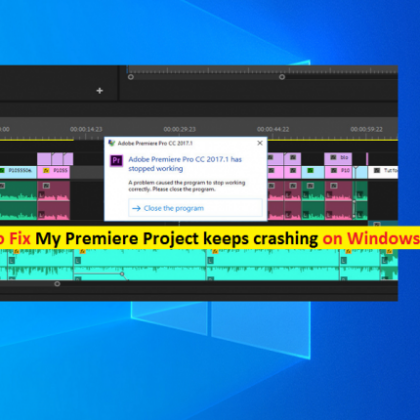What is ‘The semaphore timeout period has expired’ error in Windows 10?
If you are experiencing ‘The semaphore timeout period has expired Windows 10’ error while trying to open files/folders from external hard disk drive, then you are in right place for the solution. Here, you will be guided with easy steps/methods to resolve the issue. Let’s starts the discussion.
‘The semaphore timeout period has expired’ error: It is common Windows problem associated with Windows image backup error. This error is usually occurred when you attempt to backup large size of files, or create Windows Image backup. It prevents you from creating Windows image backup form some reasons. Let’s take a look at error message.
“The backup failed.
Windows Backup encountered an error when accessing the remote shared folder. Please retry the operation after making sure that the remote shared folder is available and accessible. (0x8078015B)
Additional Information:
The semaphore timeout period has expired. (0x80070079)”
This error can also be occurred when you trying to open or transfer some files/folders from external hard drive connected to your computer, or data stored on local network. This error is appeared with some error code 0x8078015B and 0x80070079 and saying please retry the operation after making sure the remote shared folder is available and accessible.
The possible reason behind ‘The semaphore timeout period has expired’ error can be corruption in system files or registry, corruption in hard disk drives, outdated or corrupted network adapters, interfere by your third-party antivirus or Windows Firewall, and other reasons. Let’s go for the solution.
How to fix The semaphore timeout period has expired Windows 10?
Method 1: Fix ‘The semaphore timeout period has expired’ error with ‘PC Repair Tool’
If you are facing this error due to some problems with your Windows computer, then you can try to fix the issue with ‘PC Repair Tool’. This software offers you to find and fix BSOD errors, DLL errors, EXE errors, problems with programs, malware or viruses issue, system files or registry issues, and other system issues with just few clicks. You can get this tool through button/link below.
⇓ Get PC Repair Tool
Method 2: Run SFC Scan, DISM Scan and CHKDSK Scan in Windows 10
You can fix this issue by running SFC Scan to repair system files, running DISM scan to repair hard disk image and running CHKDSK Scan to repair hard disk issues, in order to resolve this error.
Step 1: Press ‘Windows + X’ keys on keyboard and select ‘Command Prompt as Administrator’
Step 2: Run SFC Scan. Type ‘sfc /scannow’ command and hit ‘Enter’ key to execute
Step 3: Once executed, run DISM scan. Type the following command and hit ‘Enter’ key to execute
DISM /Online /Cleanup-Image /RestoreHealth
Step 4: Once executed, run CHKDSK Scan. Type ‘chkdsk C: /f’ command and hit ‘Enter’ key to execute
Step 5: Wait to finish the process. Once done, restart your computer and check if the error is resolved.
Method 3: Disable Windows Firewall and third-party antivirus software
One possible way to resolve the issue is to disable your third-party antivirus and Windows Firewall in Widows 10.
To disable antivirus: Right-click on your antivirus icon on ‘System Tray’ and select ‘Disable’, ‘Stop’, ‘Quit’ or similar option to disable it
To disable Firewall, follow steps below:
Step 1: Type ‘Firewall’ in ‘Windows Search Box’ and open it
Step 2: Select ‘Turn Windows Firewall On or OFF’ option in left pane, and select ‘Turn OFF Windows Firewall’ under ‘Private’ and ‘Public’ network settings
Step 3: Finally, hit ‘Ok’ button to save the changes and check if the trouble is resolved.
Method 4: Update Network Adapter drivers
Updating Network adapter driver can resolve the issue. Let’s try.
Step 1: Press ‘Windows + X’ keys on keyboard and select ‘Device Manager’
Step 2: Expand ‘Network Adapters’ category, right-click on your ‘Network Adapter’ and select ‘Update Driver Software… ’
Step 3: Follow on-screen instructions to finish update process. Once done, restart your computer and check if the error is resolved.
Update Network Adapter drivers [Automatically]
You can also try to update your network adapter driver with ‘Automatic Driver Update Tool’. This software will automatically find the latest updates for all Windows drivers, and then install them into your computer.
⇓ Get Automatic Driver Update Tool
Method 5: Remove HDD in Device Manager
Another possible way to resolve the issue sit to remove HDD from Device Manager or disable it.
Step 1: Open ‘Device Manager’ and expand ‘Universal Serial Bus Controllers’ category
Step 2: Find and right-click on your HDD device and select ‘Disable Device’. Once done, please check if the trouble is resolved.
Method 6: Format your external HDD as NTFS File System
You should make sure your external hard disk drive is set to ‘NTFS Mode’. If not, you can format your external hard drive as NTFS File System in order to fix the issue. Let’s try.
Step 1: Open ‘File Explorer’, locate and right-click on your external hard disk drive, and select ‘Format’
Step 2: In opened window, select ‘NTFS’ from ‘File System’ dropdown and select ‘Quick Format’ checkbox
Step 3: Finally, click on ‘Start’ button to start formatting. Once done, please check if the error is resolved.
Note: Formatting external hard drive will erase everything inside your external hard drive. So, you should create strong backup of all your personal stored in external hard disk drive on some safe storage space before formatting.
Conclusion
I am sure this article helped you on How to fix The semaphore timeout period has expired Windows 10 with several easy steps/methods. You can read & follow our instructions to resolve the issue. That’s all. For any suggestions or queries, please write on comment box below.


